(click on photos to enlarge image)
ANTIQUE SILVER TOYS MINIATURE
Silver toys have been made in many countries in
the world but nowhere as high a production figure as those made
in Holland and Great Britain. The demand for silver toys started
in the late 17th century and continued through to the end of the
19th century when for economic reasons and change of fashion the
demand for silver toys diminished. However, miniature dolls
house toys continued to be made in pewter, wood and brass and
today they are still being produced in Holland.
The fashion of dolls house was at the origin of this surge of
demand. It came from Germany at the end of the 17th century,
though models of it had been made for many years before this. In
Holland, it became fashionable amongst wealthy young ladies to
furnish dolls houses with tiny silver toys which were exact
copies of furniture and fittings used in their own homes. The
dolls house was used to show to the girls how the interior of
the house should be laid out, so that the young lady had the
right education when she had their own home to manage. The
novelty caught on, and wealthy merchants and bankers wives took
it on board and decided their dolls houses would be equipped
with every finest silver toy object of furniture and accessories
one would expect to find in an 18th century luxurious mansion of
Holland or London.
There was great rivalry amongst the ladies to ensure that their
dolls house was equipped with the latest fashion furniture and
miniature silversmiths were constantly required to provide new
models in household furniture to exhibit to family and friends.
These silver toys were not meant to be played with by children,
especially as many of them were so small they could easily be
swallowed by a baby. Silver toys specially made to be played by
children were much larger, about a third the size of a proper
object, and are very rare today as most of them, damaged by use,
have been melted down centuries ago.
Silver toys items are very scarce and highly collectable today
and a tiny pot half inch high made in the 18th century by a well
known silversmith can fetch thousands of pounds. The examples
shown below are of recent production and every item costs less
than £100.
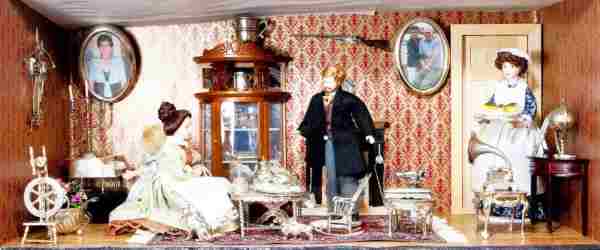
Individual box fitted out as a Victorian lounge with
silver objects collected by the author
|
It is fascinating to see how a
person might pass, in an antique shop, by the observation of a
full size silver item such as a tea pot to the ecstatic
admiration of a miniaturised copy of the same item. It is
difficult to form an answer as to why we are so taken in by
these tiny objects. Perhaps it's the marveling at the skill of
the craftsman who has had the patience and the ability to make a
miniature or because the human race is besotted with tiny things
like babies, puppies and kittens. Little toys, being small and
cute, come into the same category.
In Amsterdam, whole families were involved in creating these
tiny articles of silver because the demand was so great. Some of
the well known silversmiths dedicated to making toys in the 18th
century were:
Arnold van Geffen and family1764
Peter van Somervile and family 1710
William van Strant and family 1715
Today, most of the items made by these silversmiths would be in
four figures to buy at auctions, plus commission, plus vat.
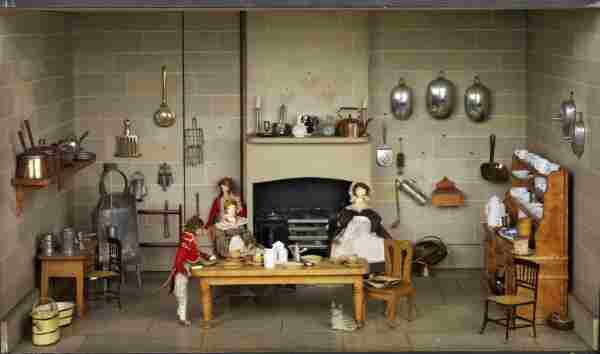
A picture of the interior of a Georgian kitchen
fitted out with silver toy utensils
Courtesy of Victoria and Albert Museum
|
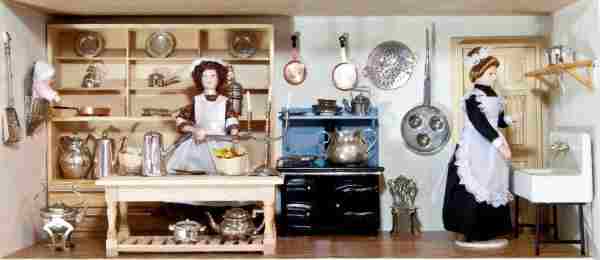
A Victorian kitchen fitted out with silver toys
designed as before by the author
|
Most of the articles had
hallmarks, even if it was only the maker's initials. The three
18th century well known silversmiths mentioned in this article
had distinctive silver marks which are easy to trace. In the
early 19th century Holland introduced a small sword stamping
onto silver. These vary in size and pattern but clearly state
the period over which the toy had been produced. There was a
system of swords stamped on the toy starting with a very small
one. The small sword on the left was used in the period
1814-1905 and the long sword next to it in 1906-1953. The two on
the right are much later and have the silver quality stamped on
the blade. The addition of a dolphin stamped on the toy dates it
to 1859-1893.
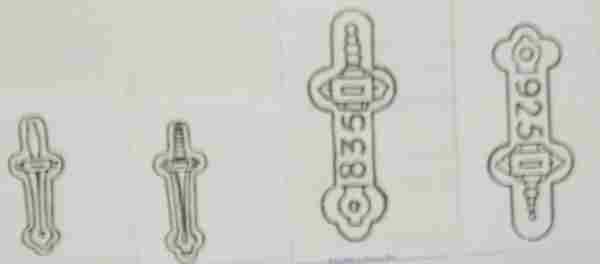
It is the design of the swords starting with the
smallest on the left which denotes its period of
manufacture
|
The Dutch Government introduced a
hallmarking system based on an alphabetical letter denoting the
year of manufacture of the silver item. This started in 1815 and
the letter was set within a circle after 1835. This was similar
to the British date letter system.
The interest in making tiny copies or miniatures of items in
everyday use dates back hundreds of years. Man seems to have
always had a yearning to miniaturise objects. The craftsmen
always liked to model items which were made in their respective
trades. Glass blowers would make tiny glasses, exact replicas of
the originals. Cabinet makers would make tiny dolls house
furniture of a standard equal to, if not better, than full size
original. The making of tiny objects was indeed a craft of love.
It was, and still is, a fairy tale world. It is the world that
was laid out in Gulliver's travels, revealing minuscule objects
which are exact copies of the real thing.
It matters not what type of materials were used in the
construction of the tiny replicas. European adults have taken,
since at least the 17th century, an interest in tiny toy objects
they could display in dolls or baby houses. Although originally
intended for children to use, the tiny toy replicas fascinated
the adults even more. So much so, that the child was allowed to
see the interior of the dolls house, only under parental
supervision, and with strict instructions they could look, but
mustn't touch.
This obsession of miniaturising everyday items has not
diminished over the years and even today there is a growing
demanding market seeking even tinier and more accurate dolls
house toys in silver.
From the history of toy miniatures it can be seen that Holland,
America, Great Britain, France and Germany have shown a definite
interest in tiny toys. However there are other countries that
have entered the silver toys market. China and Russia have
produced small silver toys but not in any profusion like the
Dutch. We in England use the term 'silver toys' which
suffice in naming the item, but the word miniature needs to be
included when meaning items so small they will not look out of
place in a dolls house. The Dutch word for silver toys is
zilverspeelgoed.
It was Holland who seemed to specialise in silver toys to be
kept in display cabinets. Today, it is still possible to build
up a wide collection of these amusing collectables. The English
silversmiths usually concentrated on dining tableware plates,
dishes, cutlery, coffee pots and candlesticks. The Dutch kept on
producing silver toys they could sell in their country and
export. One of the main toys they sold was groups of people (men,
women and children) engaged in everyday activities.
Small character displays continue to be produced today, often
employing ancient moulds used by their forefathers. In the
majority of cases the figures are mounted on silver bases on
which are stamped the Dutch hallmarks and maker's initials.
Silver toys are still made today in Schoonhoven, Holland.
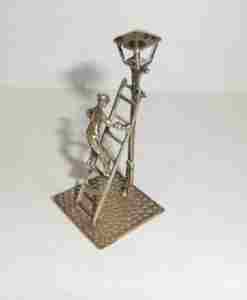
The lamplighter
|
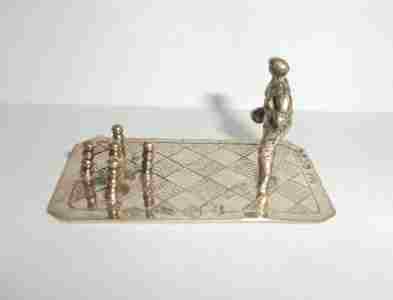
The bowler
|
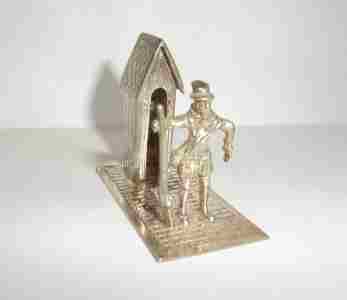
The sentry box
|
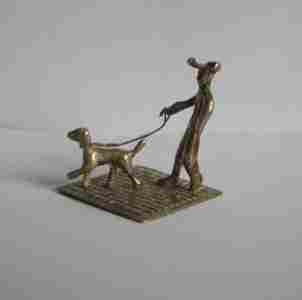
Walking the dog
|
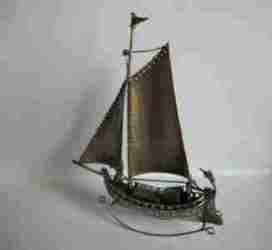
The ship
|
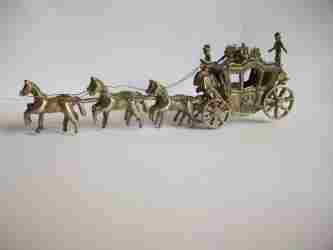
Horses and carriage
|
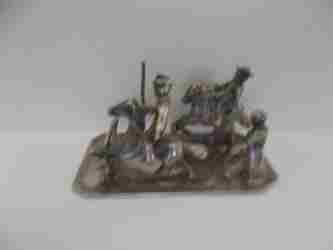
The steeplechase
. |
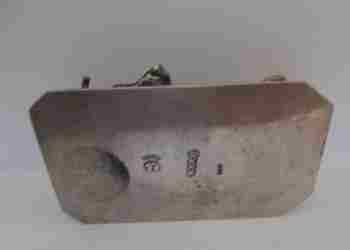
The underside of the picture on the left
showing the
stamp marks |
The best known craftsmen in the UK established in the late 17th
to mid 18th century were George Mountjoy, and later, David
Clayton. They both made superb silver toys, the majority being
household and dining accessories; a great many of which can be
found at the Victoria and Albert museum.
In many ways they were superior to their Dutch rivals. In the
early 18th century there were more than 40 resident silversmiths
working in Amsterdam on producing silver toys, many specialised
in this art.
Very few books have been written on the subject of silver toys,
and it is 30 years since Victor Houart wrote his magnificent
book called Miniature Silver Toys which has been
translated from the French by David Smith. He states himself
that a great deal of research is still needed on the
silversmiths of those days and the making of silver toys in
England; a subject of which little is known.
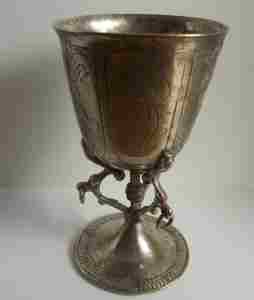
A Dutch snake cup |
These tiny chalices were called Snake cups in Holland. This one
is a 19th century copy and is clearly stamped with a small sword,
over which a key has been pressed to denote articles for export
1852-1953.
It is a fascinating hobby collecting tiny silver toys and
miniatures. It is apparent from the volume of sales on eBay that
most of the items on sale are now slowly increasing in price.
The practice of collecting these comparatively cheap silver toys
is a good hobby and investment. Americans are selling many toys
but the European buyer has to pay high postage and possibly
import tax.
There were thousands of these tiny silver toys made, and many of
them especially the toys from the 18th century are in museums
around the world, or in wealthy people's collections. It is easy
today to start a collection, the prices, though they are rising,
are still affordable, and antique shops and fairs do sell them.
Although the toys may have been manufactured in the 19th century
they are increasing in value and will become scarce.
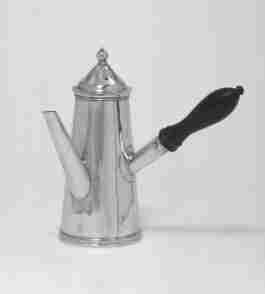
A coffee pot by David Clayton
Courtesy of Victoria & Albert museum |
They also made many kinds of wild animals and birds. In fact
there was nothing these silversmiths seemed to have overlooked.
It is a delight to see how their imagination has expanded into
making sets of coach and horses with and without passengers.
They made sleighs, pulled by horses, and oxen. The sleighs are
often filled with tiny models of passengers and driver, and,
although the figures are no more than half an inch high, they
are dressed in fashionable clothes of the period and are not
only sat in their transport but carry umbrellas, swords and
walking sticks.
For many years there was very little interest in these tiny
silver toys, some with centuries of history behind them. Even
today it is near impossible to find information about the famous
silversmiths of the 18th and 19th century. Although there are
copies and forgeries appearing, many pieces bear town and
maker's mark.
This is a book the author has written on the subject of silver
toys and miniatures.
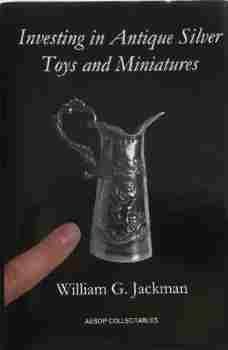
Investing in Antique Silver toys
9780956909800 AESOP (2011) A
It includes an illustrated price list
|
|

